Strategic Analysis and Planning Report: Moana New Zealand's Strategy
VerifiedAdded on 2023/04/20
|17
|4466
|381
Report
AI Summary
This report presents a strategic analysis and planning report focusing on Moana New Zealand, the largest Maori-owned fisheries company. It begins with an introduction to strategic analysis and its importance in organizational planning. The report then delves into organizational performance, exploring stakeholder collaboration (internal and external) to address challenges in the external environment, including labor force, legal considerations, financial management, and customer base. The analysis includes the identification of issues and challenges faced by Moana New Zealand and proposes solutions through stakeholder collaboration. Further, the report examines the application of professional, ethical, social, and cultural behaviors in managing the impact of the external environment. Two models for evaluating innovative and change strategies, the McKinsey 7S model and Lewin's change management model, are applied to improve business performance. The report also explores an analytical technique for stakeholder analysis and provides eight ways for consulting stakeholders. Finally, it evaluates motivational models for professional development, suggesting a model for leadership behavior and continuous improvement, providing justifications for the choices.
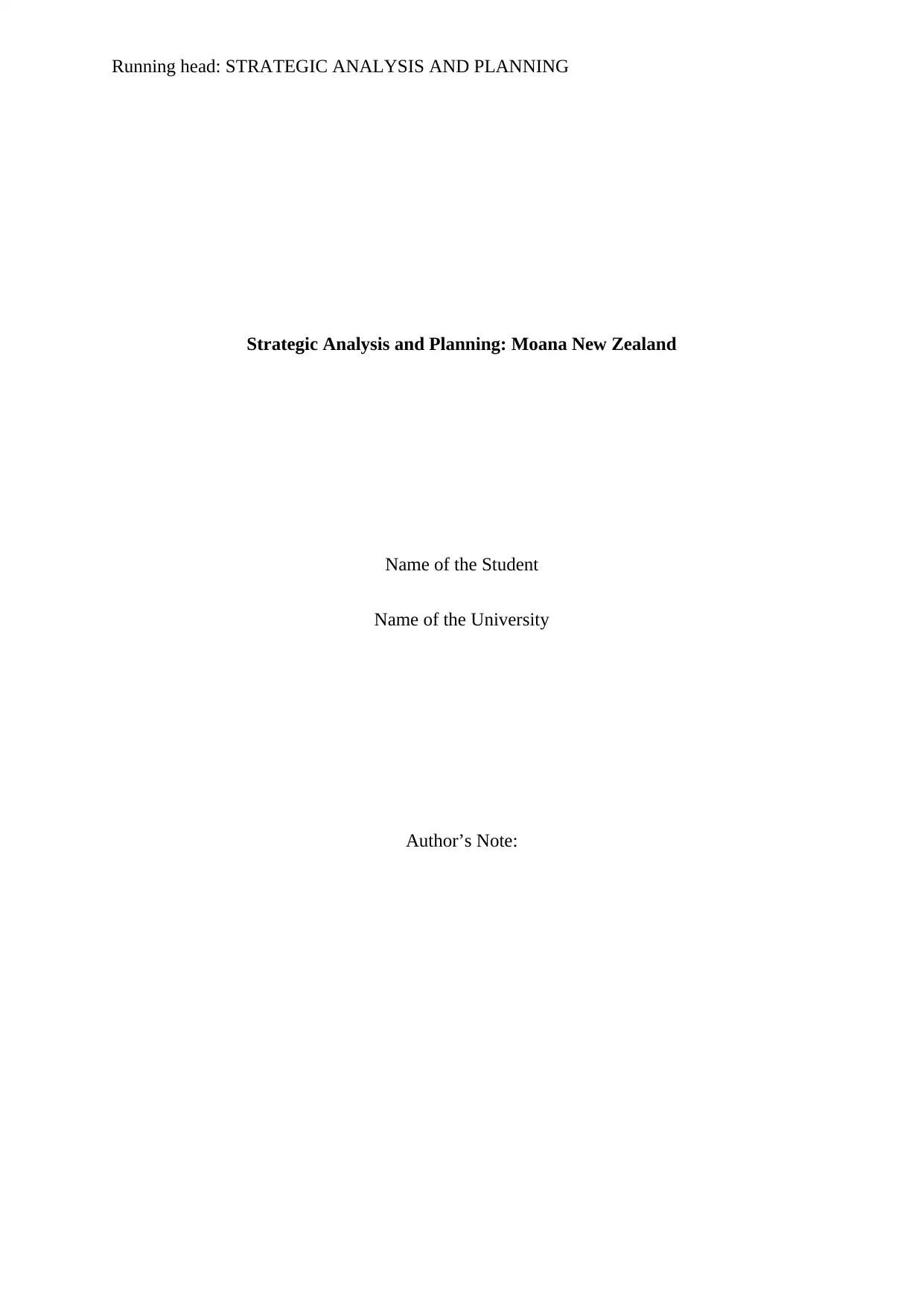
Running head: STRATEGIC ANALYSIS AND PLANNING
Strategic Analysis and Planning: Moana New Zealand
Name of the Student
Name of the University
Author’s Note:
Strategic Analysis and Planning: Moana New Zealand
Name of the Student
Name of the University
Author’s Note:
Paraphrase This Document
Need a fresh take? Get an instant paraphrase of this document with our AI Paraphraser
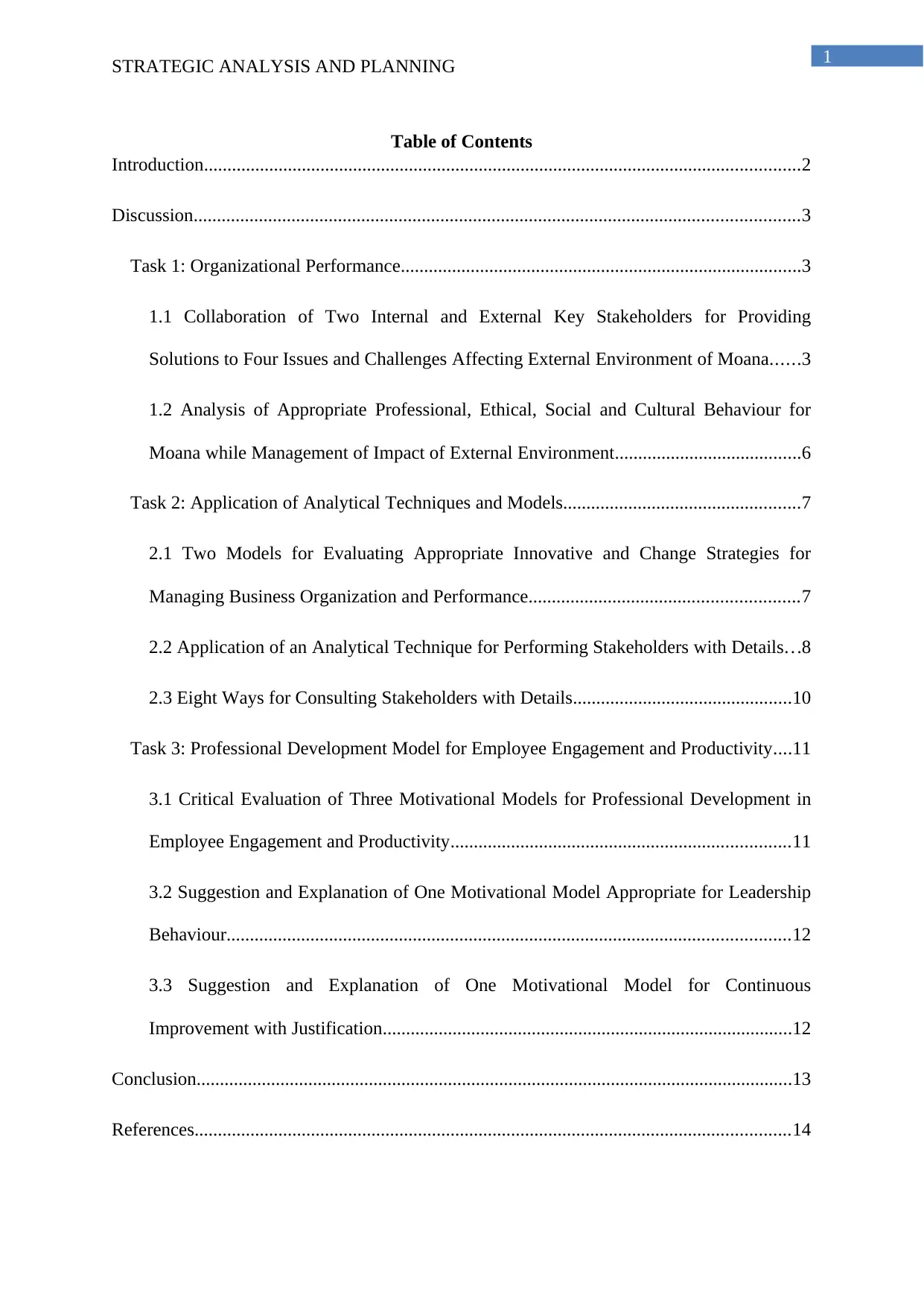
1
STRATEGIC ANALYSIS AND PLANNING
Table of Contents
Introduction................................................................................................................................2
Discussion..................................................................................................................................3
Task 1: Organizational Performance......................................................................................3
1.1 Collaboration of Two Internal and External Key Stakeholders for Providing
Solutions to Four Issues and Challenges Affecting External Environment of Moana......3
1.2 Analysis of Appropriate Professional, Ethical, Social and Cultural Behaviour for
Moana while Management of Impact of External Environment........................................6
Task 2: Application of Analytical Techniques and Models...................................................7
2.1 Two Models for Evaluating Appropriate Innovative and Change Strategies for
Managing Business Organization and Performance..........................................................7
2.2 Application of an Analytical Technique for Performing Stakeholders with Details...8
2.3 Eight Ways for Consulting Stakeholders with Details...............................................10
Task 3: Professional Development Model for Employee Engagement and Productivity....11
3.1 Critical Evaluation of Three Motivational Models for Professional Development in
Employee Engagement and Productivity.........................................................................11
3.2 Suggestion and Explanation of One Motivational Model Appropriate for Leadership
Behaviour.........................................................................................................................12
3.3 Suggestion and Explanation of One Motivational Model for Continuous
Improvement with Justification........................................................................................12
Conclusion................................................................................................................................13
References................................................................................................................................14
STRATEGIC ANALYSIS AND PLANNING
Table of Contents
Introduction................................................................................................................................2
Discussion..................................................................................................................................3
Task 1: Organizational Performance......................................................................................3
1.1 Collaboration of Two Internal and External Key Stakeholders for Providing
Solutions to Four Issues and Challenges Affecting External Environment of Moana......3
1.2 Analysis of Appropriate Professional, Ethical, Social and Cultural Behaviour for
Moana while Management of Impact of External Environment........................................6
Task 2: Application of Analytical Techniques and Models...................................................7
2.1 Two Models for Evaluating Appropriate Innovative and Change Strategies for
Managing Business Organization and Performance..........................................................7
2.2 Application of an Analytical Technique for Performing Stakeholders with Details...8
2.3 Eight Ways for Consulting Stakeholders with Details...............................................10
Task 3: Professional Development Model for Employee Engagement and Productivity....11
3.1 Critical Evaluation of Three Motivational Models for Professional Development in
Employee Engagement and Productivity.........................................................................11
3.2 Suggestion and Explanation of One Motivational Model Appropriate for Leadership
Behaviour.........................................................................................................................12
3.3 Suggestion and Explanation of One Motivational Model for Continuous
Improvement with Justification........................................................................................12
Conclusion................................................................................................................................13
References................................................................................................................................14
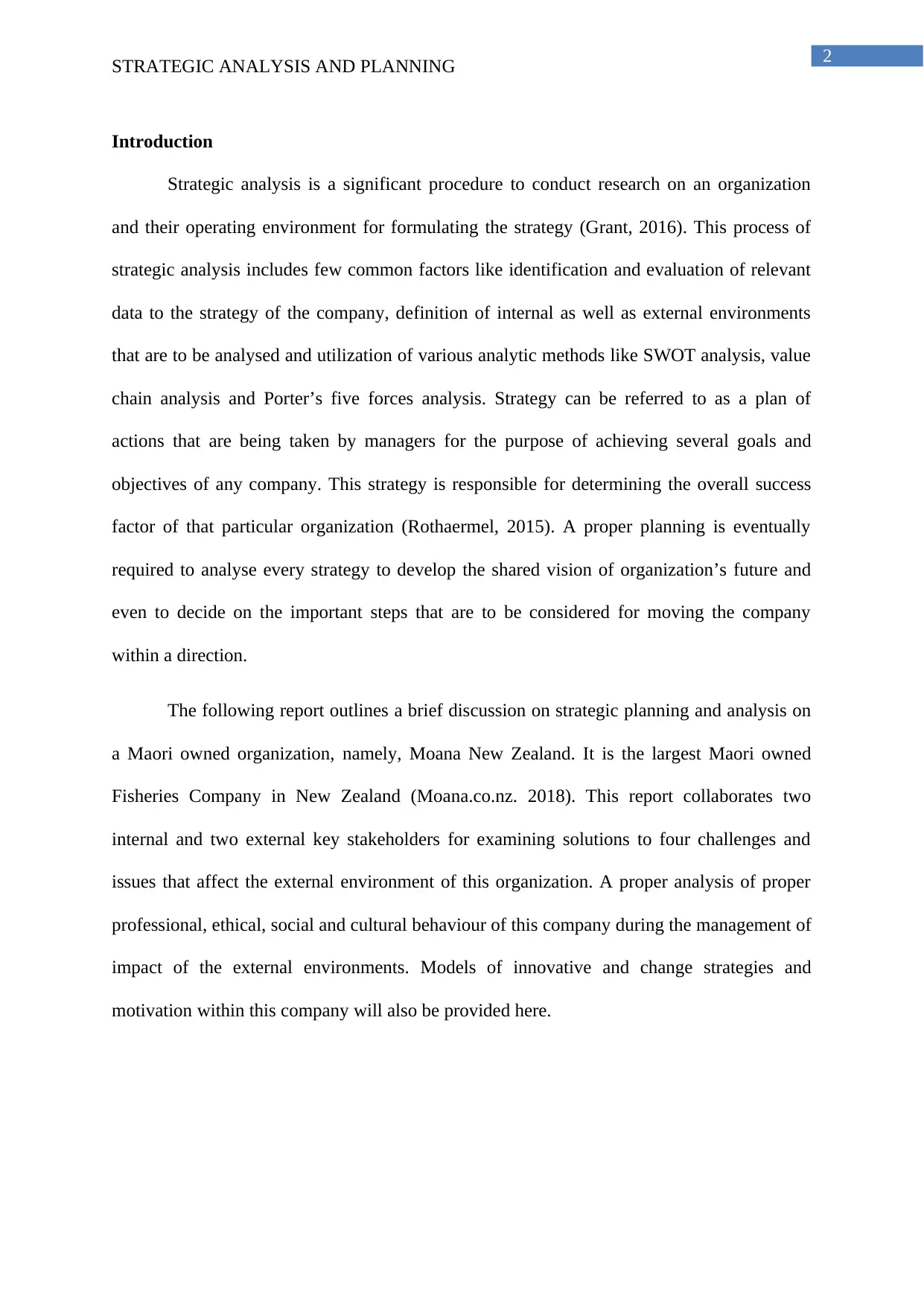
2
STRATEGIC ANALYSIS AND PLANNING
Introduction
Strategic analysis is a significant procedure to conduct research on an organization
and their operating environment for formulating the strategy (Grant, 2016). This process of
strategic analysis includes few common factors like identification and evaluation of relevant
data to the strategy of the company, definition of internal as well as external environments
that are to be analysed and utilization of various analytic methods like SWOT analysis, value
chain analysis and Porter’s five forces analysis. Strategy can be referred to as a plan of
actions that are being taken by managers for the purpose of achieving several goals and
objectives of any company. This strategy is responsible for determining the overall success
factor of that particular organization (Rothaermel, 2015). A proper planning is eventually
required to analyse every strategy to develop the shared vision of organization’s future and
even to decide on the important steps that are to be considered for moving the company
within a direction.
The following report outlines a brief discussion on strategic planning and analysis on
a Maori owned organization, namely, Moana New Zealand. It is the largest Maori owned
Fisheries Company in New Zealand (Moana.co.nz. 2018). This report collaborates two
internal and two external key stakeholders for examining solutions to four challenges and
issues that affect the external environment of this organization. A proper analysis of proper
professional, ethical, social and cultural behaviour of this company during the management of
impact of the external environments. Models of innovative and change strategies and
motivation within this company will also be provided here.
STRATEGIC ANALYSIS AND PLANNING
Introduction
Strategic analysis is a significant procedure to conduct research on an organization
and their operating environment for formulating the strategy (Grant, 2016). This process of
strategic analysis includes few common factors like identification and evaluation of relevant
data to the strategy of the company, definition of internal as well as external environments
that are to be analysed and utilization of various analytic methods like SWOT analysis, value
chain analysis and Porter’s five forces analysis. Strategy can be referred to as a plan of
actions that are being taken by managers for the purpose of achieving several goals and
objectives of any company. This strategy is responsible for determining the overall success
factor of that particular organization (Rothaermel, 2015). A proper planning is eventually
required to analyse every strategy to develop the shared vision of organization’s future and
even to decide on the important steps that are to be considered for moving the company
within a direction.
The following report outlines a brief discussion on strategic planning and analysis on
a Maori owned organization, namely, Moana New Zealand. It is the largest Maori owned
Fisheries Company in New Zealand (Moana.co.nz. 2018). This report collaborates two
internal and two external key stakeholders for examining solutions to four challenges and
issues that affect the external environment of this organization. A proper analysis of proper
professional, ethical, social and cultural behaviour of this company during the management of
impact of the external environments. Models of innovative and change strategies and
motivation within this company will also be provided here.
⊘ This is a preview!⊘
Do you want full access?
Subscribe today to unlock all pages.

Trusted by 1+ million students worldwide
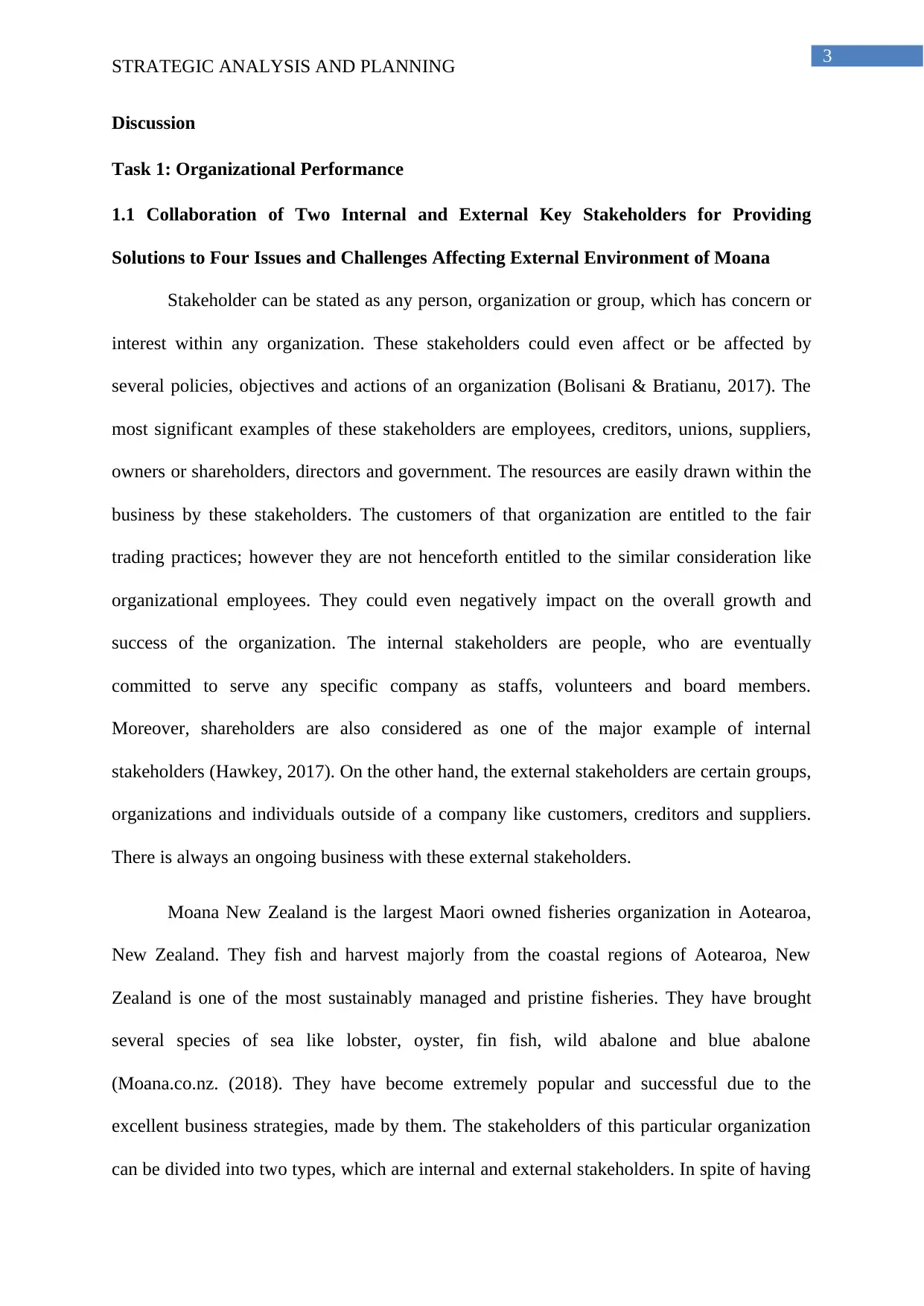
3
STRATEGIC ANALYSIS AND PLANNING
Discussion
Task 1: Organizational Performance
1.1 Collaboration of Two Internal and External Key Stakeholders for Providing
Solutions to Four Issues and Challenges Affecting External Environment of Moana
Stakeholder can be stated as any person, organization or group, which has concern or
interest within any organization. These stakeholders could even affect or be affected by
several policies, objectives and actions of an organization (Bolisani & Bratianu, 2017). The
most significant examples of these stakeholders are employees, creditors, unions, suppliers,
owners or shareholders, directors and government. The resources are easily drawn within the
business by these stakeholders. The customers of that organization are entitled to the fair
trading practices; however they are not henceforth entitled to the similar consideration like
organizational employees. They could even negatively impact on the overall growth and
success of the organization. The internal stakeholders are people, who are eventually
committed to serve any specific company as staffs, volunteers and board members.
Moreover, shareholders are also considered as one of the major example of internal
stakeholders (Hawkey, 2017). On the other hand, the external stakeholders are certain groups,
organizations and individuals outside of a company like customers, creditors and suppliers.
There is always an ongoing business with these external stakeholders.
Moana New Zealand is the largest Maori owned fisheries organization in Aotearoa,
New Zealand. They fish and harvest majorly from the coastal regions of Aotearoa, New
Zealand is one of the most sustainably managed and pristine fisheries. They have brought
several species of sea like lobster, oyster, fin fish, wild abalone and blue abalone
(Moana.co.nz. (2018). They have become extremely popular and successful due to the
excellent business strategies, made by them. The stakeholders of this particular organization
can be divided into two types, which are internal and external stakeholders. In spite of having
STRATEGIC ANALYSIS AND PLANNING
Discussion
Task 1: Organizational Performance
1.1 Collaboration of Two Internal and External Key Stakeholders for Providing
Solutions to Four Issues and Challenges Affecting External Environment of Moana
Stakeholder can be stated as any person, organization or group, which has concern or
interest within any organization. These stakeholders could even affect or be affected by
several policies, objectives and actions of an organization (Bolisani & Bratianu, 2017). The
most significant examples of these stakeholders are employees, creditors, unions, suppliers,
owners or shareholders, directors and government. The resources are easily drawn within the
business by these stakeholders. The customers of that organization are entitled to the fair
trading practices; however they are not henceforth entitled to the similar consideration like
organizational employees. They could even negatively impact on the overall growth and
success of the organization. The internal stakeholders are people, who are eventually
committed to serve any specific company as staffs, volunteers and board members.
Moreover, shareholders are also considered as one of the major example of internal
stakeholders (Hawkey, 2017). On the other hand, the external stakeholders are certain groups,
organizations and individuals outside of a company like customers, creditors and suppliers.
There is always an ongoing business with these external stakeholders.
Moana New Zealand is the largest Maori owned fisheries organization in Aotearoa,
New Zealand. They fish and harvest majorly from the coastal regions of Aotearoa, New
Zealand is one of the most sustainably managed and pristine fisheries. They have brought
several species of sea like lobster, oyster, fin fish, wild abalone and blue abalone
(Moana.co.nz. (2018). They have become extremely popular and successful due to the
excellent business strategies, made by them. The stakeholders of this particular organization
can be divided into two types, which are internal and external stakeholders. In spite of having
Paraphrase This Document
Need a fresh take? Get an instant paraphrase of this document with our AI Paraphraser
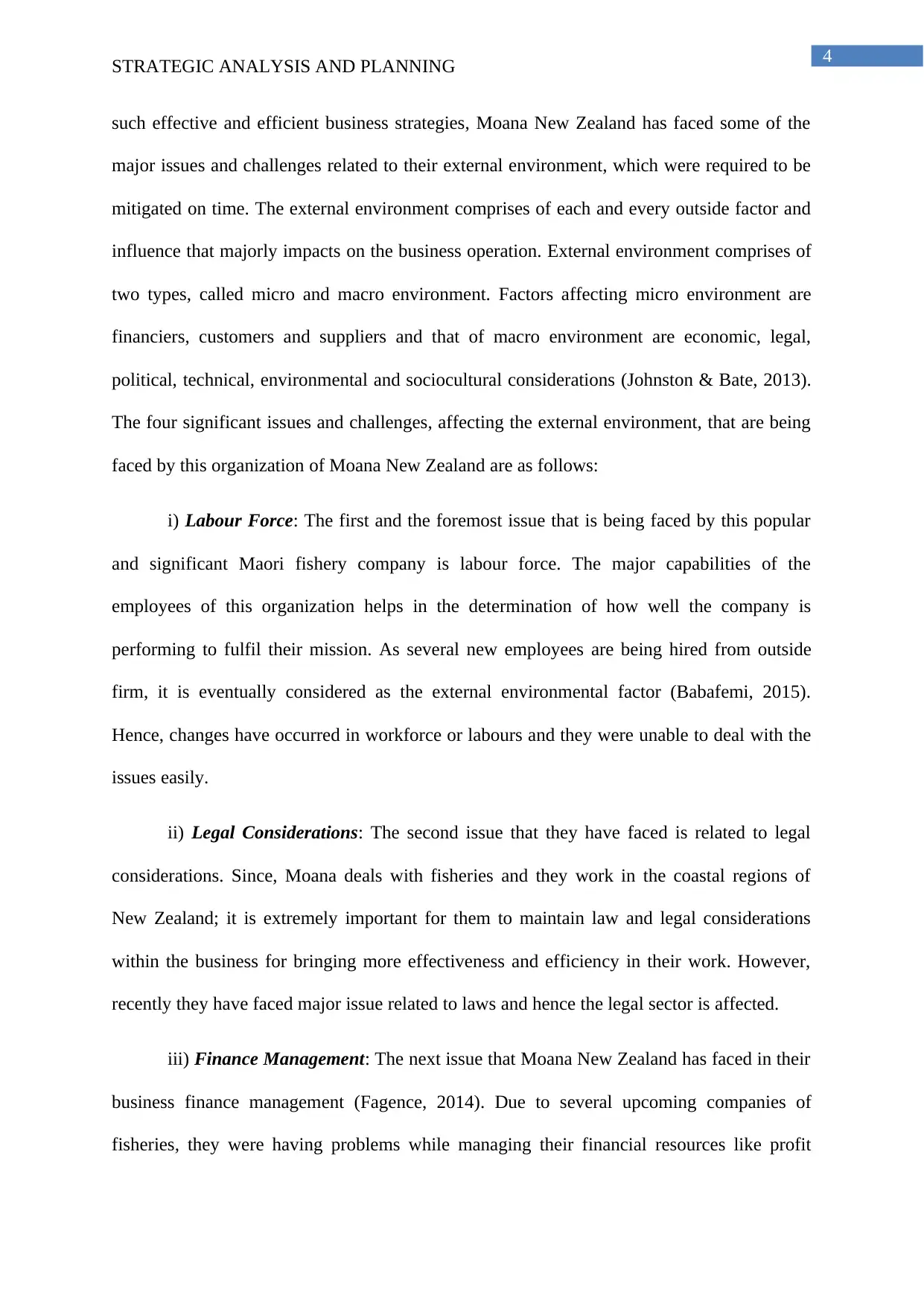
4
STRATEGIC ANALYSIS AND PLANNING
such effective and efficient business strategies, Moana New Zealand has faced some of the
major issues and challenges related to their external environment, which were required to be
mitigated on time. The external environment comprises of each and every outside factor and
influence that majorly impacts on the business operation. External environment comprises of
two types, called micro and macro environment. Factors affecting micro environment are
financiers, customers and suppliers and that of macro environment are economic, legal,
political, technical, environmental and sociocultural considerations (Johnston & Bate, 2013).
The four significant issues and challenges, affecting the external environment, that are being
faced by this organization of Moana New Zealand are as follows:
i) Labour Force: The first and the foremost issue that is being faced by this popular
and significant Maori fishery company is labour force. The major capabilities of the
employees of this organization helps in the determination of how well the company is
performing to fulfil their mission. As several new employees are being hired from outside
firm, it is eventually considered as the external environmental factor (Babafemi, 2015).
Hence, changes have occurred in workforce or labours and they were unable to deal with the
issues easily.
ii) Legal Considerations: The second issue that they have faced is related to legal
considerations. Since, Moana deals with fisheries and they work in the coastal regions of
New Zealand; it is extremely important for them to maintain law and legal considerations
within the business for bringing more effectiveness and efficiency in their work. However,
recently they have faced major issue related to laws and hence the legal sector is affected.
iii) Finance Management: The next issue that Moana New Zealand has faced in their
business finance management (Fagence, 2014). Due to several upcoming companies of
fisheries, they were having problems while managing their financial resources like profit
STRATEGIC ANALYSIS AND PLANNING
such effective and efficient business strategies, Moana New Zealand has faced some of the
major issues and challenges related to their external environment, which were required to be
mitigated on time. The external environment comprises of each and every outside factor and
influence that majorly impacts on the business operation. External environment comprises of
two types, called micro and macro environment. Factors affecting micro environment are
financiers, customers and suppliers and that of macro environment are economic, legal,
political, technical, environmental and sociocultural considerations (Johnston & Bate, 2013).
The four significant issues and challenges, affecting the external environment, that are being
faced by this organization of Moana New Zealand are as follows:
i) Labour Force: The first and the foremost issue that is being faced by this popular
and significant Maori fishery company is labour force. The major capabilities of the
employees of this organization helps in the determination of how well the company is
performing to fulfil their mission. As several new employees are being hired from outside
firm, it is eventually considered as the external environmental factor (Babafemi, 2015).
Hence, changes have occurred in workforce or labours and they were unable to deal with the
issues easily.
ii) Legal Considerations: The second issue that they have faced is related to legal
considerations. Since, Moana deals with fisheries and they work in the coastal regions of
New Zealand; it is extremely important for them to maintain law and legal considerations
within the business for bringing more effectiveness and efficiency in their work. However,
recently they have faced major issue related to laws and hence the legal sector is affected.
iii) Finance Management: The next issue that Moana New Zealand has faced in their
business finance management (Fagence, 2014). Due to several upcoming companies of
fisheries, they were having problems while managing their financial resources like profit
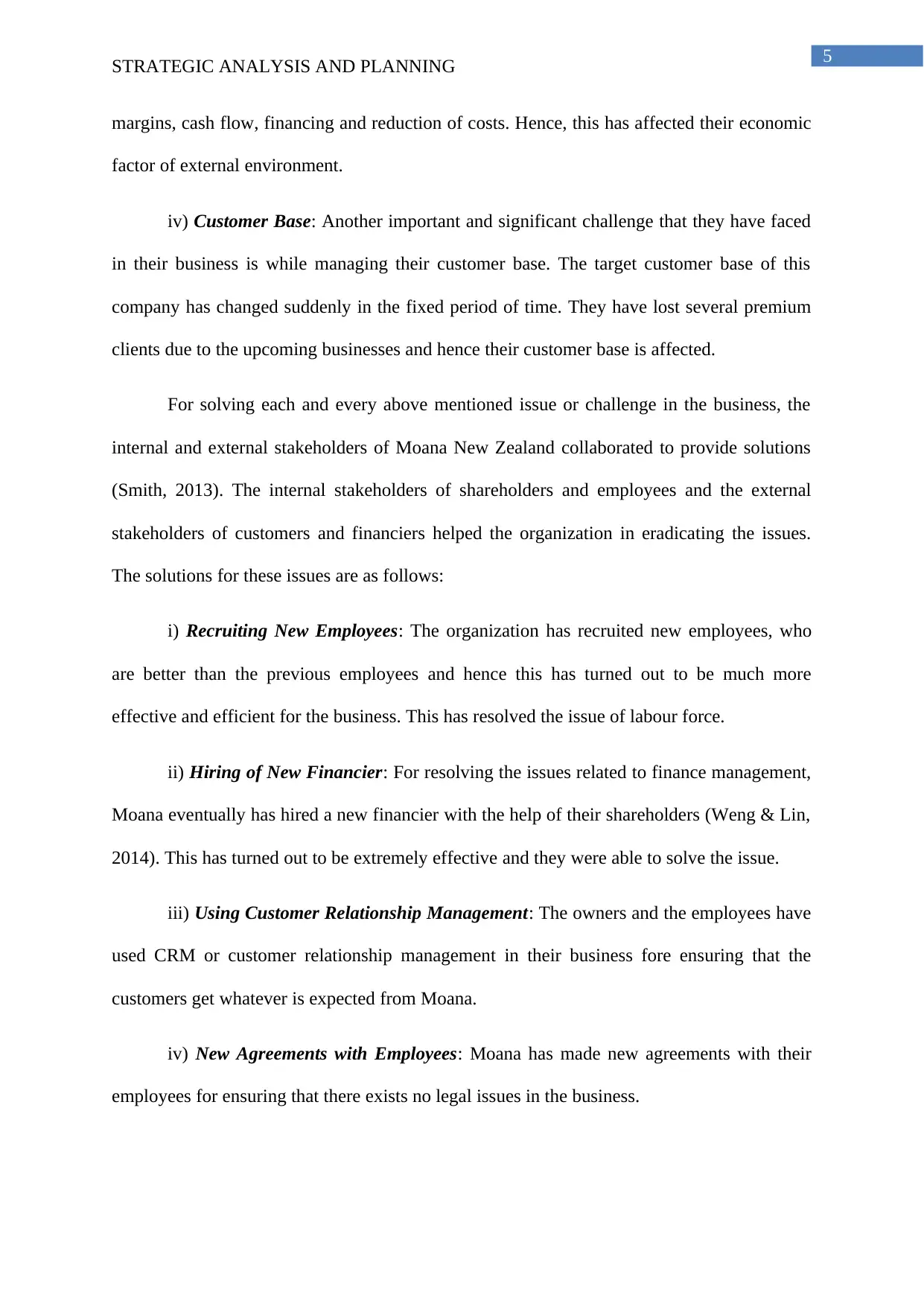
5
STRATEGIC ANALYSIS AND PLANNING
margins, cash flow, financing and reduction of costs. Hence, this has affected their economic
factor of external environment.
iv) Customer Base: Another important and significant challenge that they have faced
in their business is while managing their customer base. The target customer base of this
company has changed suddenly in the fixed period of time. They have lost several premium
clients due to the upcoming businesses and hence their customer base is affected.
For solving each and every above mentioned issue or challenge in the business, the
internal and external stakeholders of Moana New Zealand collaborated to provide solutions
(Smith, 2013). The internal stakeholders of shareholders and employees and the external
stakeholders of customers and financiers helped the organization in eradicating the issues.
The solutions for these issues are as follows:
i) Recruiting New Employees: The organization has recruited new employees, who
are better than the previous employees and hence this has turned out to be much more
effective and efficient for the business. This has resolved the issue of labour force.
ii) Hiring of New Financier: For resolving the issues related to finance management,
Moana eventually has hired a new financier with the help of their shareholders (Weng & Lin,
2014). This has turned out to be extremely effective and they were able to solve the issue.
iii) Using Customer Relationship Management: The owners and the employees have
used CRM or customer relationship management in their business fore ensuring that the
customers get whatever is expected from Moana.
iv) New Agreements with Employees: Moana has made new agreements with their
employees for ensuring that there exists no legal issues in the business.
STRATEGIC ANALYSIS AND PLANNING
margins, cash flow, financing and reduction of costs. Hence, this has affected their economic
factor of external environment.
iv) Customer Base: Another important and significant challenge that they have faced
in their business is while managing their customer base. The target customer base of this
company has changed suddenly in the fixed period of time. They have lost several premium
clients due to the upcoming businesses and hence their customer base is affected.
For solving each and every above mentioned issue or challenge in the business, the
internal and external stakeholders of Moana New Zealand collaborated to provide solutions
(Smith, 2013). The internal stakeholders of shareholders and employees and the external
stakeholders of customers and financiers helped the organization in eradicating the issues.
The solutions for these issues are as follows:
i) Recruiting New Employees: The organization has recruited new employees, who
are better than the previous employees and hence this has turned out to be much more
effective and efficient for the business. This has resolved the issue of labour force.
ii) Hiring of New Financier: For resolving the issues related to finance management,
Moana eventually has hired a new financier with the help of their shareholders (Weng & Lin,
2014). This has turned out to be extremely effective and they were able to solve the issue.
iii) Using Customer Relationship Management: The owners and the employees have
used CRM or customer relationship management in their business fore ensuring that the
customers get whatever is expected from Moana.
iv) New Agreements with Employees: Moana has made new agreements with their
employees for ensuring that there exists no legal issues in the business.
⊘ This is a preview!⊘
Do you want full access?
Subscribe today to unlock all pages.

Trusted by 1+ million students worldwide
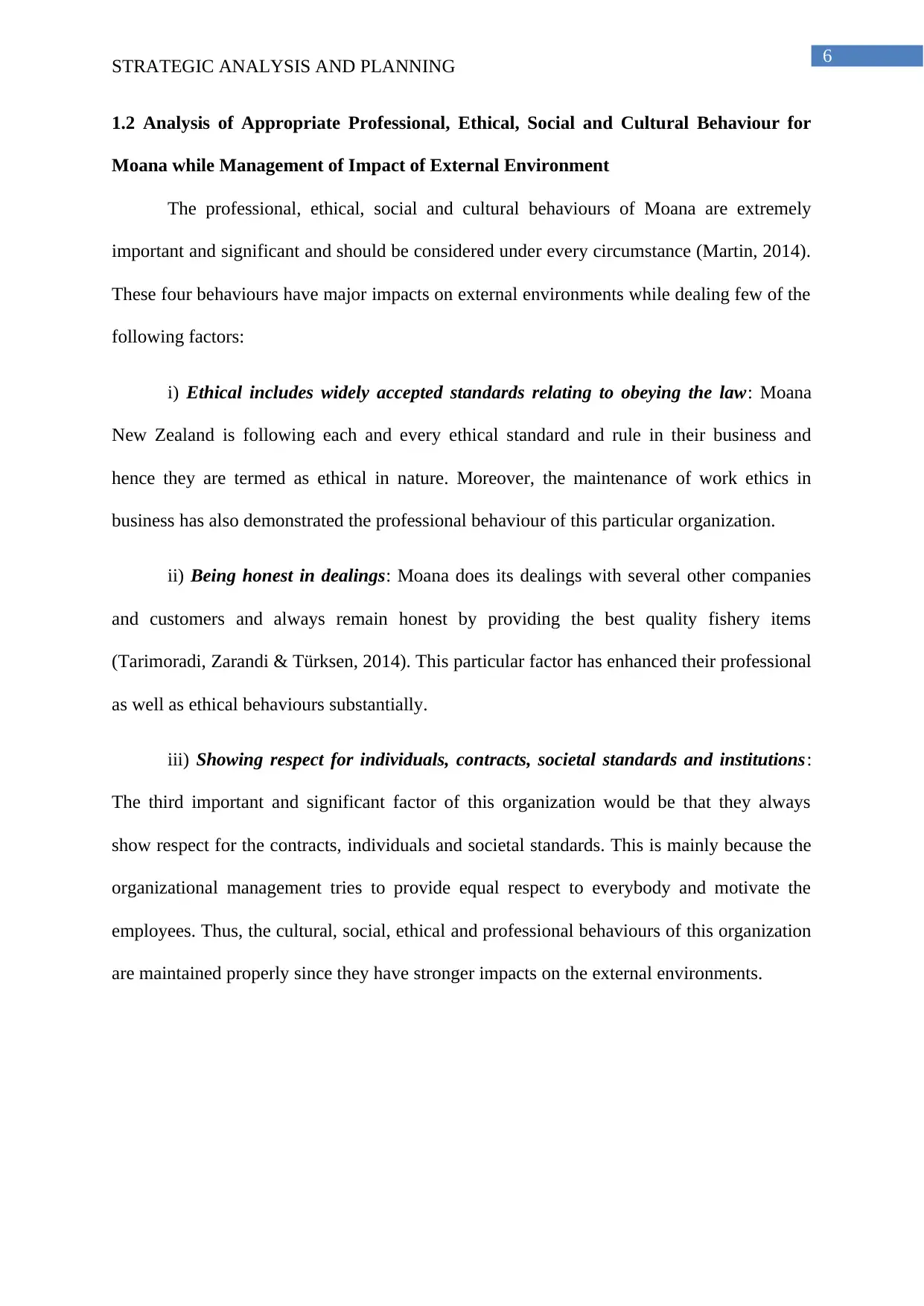
6
STRATEGIC ANALYSIS AND PLANNING
1.2 Analysis of Appropriate Professional, Ethical, Social and Cultural Behaviour for
Moana while Management of Impact of External Environment
The professional, ethical, social and cultural behaviours of Moana are extremely
important and significant and should be considered under every circumstance (Martin, 2014).
These four behaviours have major impacts on external environments while dealing few of the
following factors:
i) Ethical includes widely accepted standards relating to obeying the law: Moana
New Zealand is following each and every ethical standard and rule in their business and
hence they are termed as ethical in nature. Moreover, the maintenance of work ethics in
business has also demonstrated the professional behaviour of this particular organization.
ii) Being honest in dealings: Moana does its dealings with several other companies
and customers and always remain honest by providing the best quality fishery items
(Tarimoradi, Zarandi & Türksen, 2014). This particular factor has enhanced their professional
as well as ethical behaviours substantially.
iii) Showing respect for individuals, contracts, societal standards and institutions:
The third important and significant factor of this organization would be that they always
show respect for the contracts, individuals and societal standards. This is mainly because the
organizational management tries to provide equal respect to everybody and motivate the
employees. Thus, the cultural, social, ethical and professional behaviours of this organization
are maintained properly since they have stronger impacts on the external environments.
STRATEGIC ANALYSIS AND PLANNING
1.2 Analysis of Appropriate Professional, Ethical, Social and Cultural Behaviour for
Moana while Management of Impact of External Environment
The professional, ethical, social and cultural behaviours of Moana are extremely
important and significant and should be considered under every circumstance (Martin, 2014).
These four behaviours have major impacts on external environments while dealing few of the
following factors:
i) Ethical includes widely accepted standards relating to obeying the law: Moana
New Zealand is following each and every ethical standard and rule in their business and
hence they are termed as ethical in nature. Moreover, the maintenance of work ethics in
business has also demonstrated the professional behaviour of this particular organization.
ii) Being honest in dealings: Moana does its dealings with several other companies
and customers and always remain honest by providing the best quality fishery items
(Tarimoradi, Zarandi & Türksen, 2014). This particular factor has enhanced their professional
as well as ethical behaviours substantially.
iii) Showing respect for individuals, contracts, societal standards and institutions:
The third important and significant factor of this organization would be that they always
show respect for the contracts, individuals and societal standards. This is mainly because the
organizational management tries to provide equal respect to everybody and motivate the
employees. Thus, the cultural, social, ethical and professional behaviours of this organization
are maintained properly since they have stronger impacts on the external environments.
Paraphrase This Document
Need a fresh take? Get an instant paraphrase of this document with our AI Paraphraser
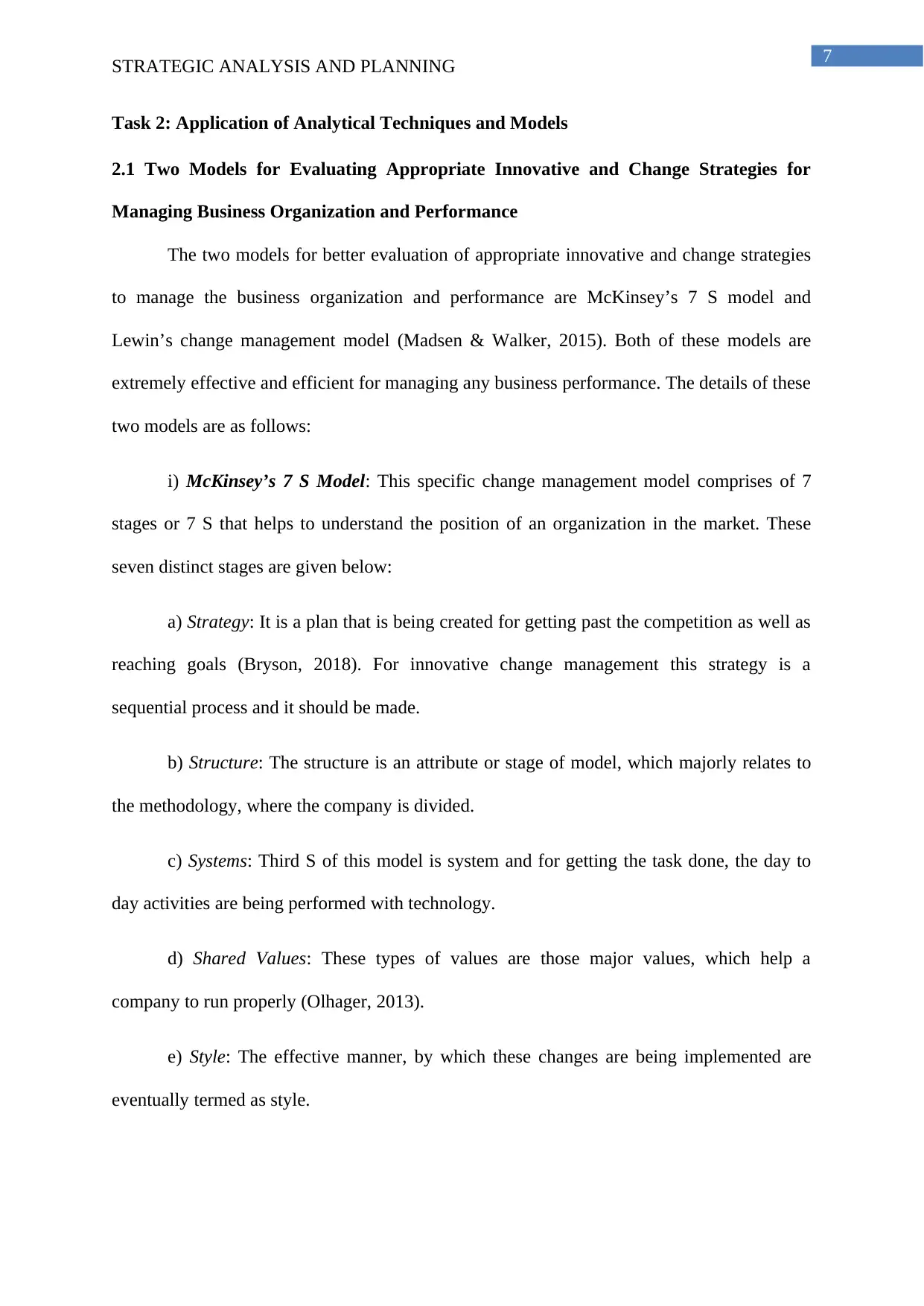
7
STRATEGIC ANALYSIS AND PLANNING
Task 2: Application of Analytical Techniques and Models
2.1 Two Models for Evaluating Appropriate Innovative and Change Strategies for
Managing Business Organization and Performance
The two models for better evaluation of appropriate innovative and change strategies
to manage the business organization and performance are McKinsey’s 7 S model and
Lewin’s change management model (Madsen & Walker, 2015). Both of these models are
extremely effective and efficient for managing any business performance. The details of these
two models are as follows:
i) McKinsey’s 7 S Model: This specific change management model comprises of 7
stages or 7 S that helps to understand the position of an organization in the market. These
seven distinct stages are given below:
a) Strategy: It is a plan that is being created for getting past the competition as well as
reaching goals (Bryson, 2018). For innovative change management this strategy is a
sequential process and it should be made.
b) Structure: The structure is an attribute or stage of model, which majorly relates to
the methodology, where the company is divided.
c) Systems: Third S of this model is system and for getting the task done, the day to
day activities are being performed with technology.
d) Shared Values: These types of values are those major values, which help a
company to run properly (Olhager, 2013).
e) Style: The effective manner, by which these changes are being implemented are
eventually termed as style.
STRATEGIC ANALYSIS AND PLANNING
Task 2: Application of Analytical Techniques and Models
2.1 Two Models for Evaluating Appropriate Innovative and Change Strategies for
Managing Business Organization and Performance
The two models for better evaluation of appropriate innovative and change strategies
to manage the business organization and performance are McKinsey’s 7 S model and
Lewin’s change management model (Madsen & Walker, 2015). Both of these models are
extremely effective and efficient for managing any business performance. The details of these
two models are as follows:
i) McKinsey’s 7 S Model: This specific change management model comprises of 7
stages or 7 S that helps to understand the position of an organization in the market. These
seven distinct stages are given below:
a) Strategy: It is a plan that is being created for getting past the competition as well as
reaching goals (Bryson, 2018). For innovative change management this strategy is a
sequential process and it should be made.
b) Structure: The structure is an attribute or stage of model, which majorly relates to
the methodology, where the company is divided.
c) Systems: Third S of this model is system and for getting the task done, the day to
day activities are being performed with technology.
d) Shared Values: These types of values are those major values, which help a
company to run properly (Olhager, 2013).
e) Style: The effective manner, by which these changes are being implemented are
eventually termed as style.
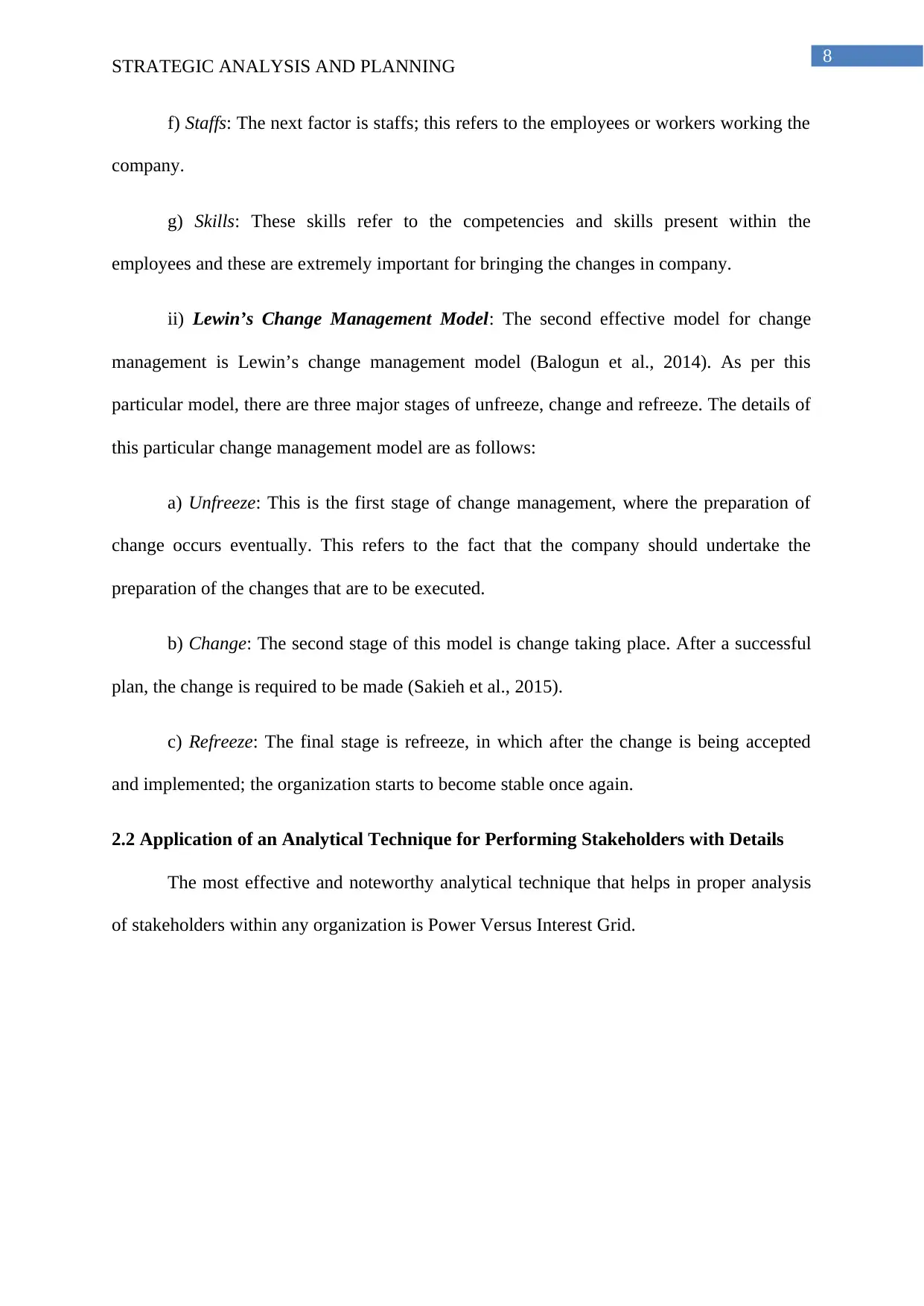
8
STRATEGIC ANALYSIS AND PLANNING
f) Staffs: The next factor is staffs; this refers to the employees or workers working the
company.
g) Skills: These skills refer to the competencies and skills present within the
employees and these are extremely important for bringing the changes in company.
ii) Lewin’s Change Management Model: The second effective model for change
management is Lewin’s change management model (Balogun et al., 2014). As per this
particular model, there are three major stages of unfreeze, change and refreeze. The details of
this particular change management model are as follows:
a) Unfreeze: This is the first stage of change management, where the preparation of
change occurs eventually. This refers to the fact that the company should undertake the
preparation of the changes that are to be executed.
b) Change: The second stage of this model is change taking place. After a successful
plan, the change is required to be made (Sakieh et al., 2015).
c) Refreeze: The final stage is refreeze, in which after the change is being accepted
and implemented; the organization starts to become stable once again.
2.2 Application of an Analytical Technique for Performing Stakeholders with Details
The most effective and noteworthy analytical technique that helps in proper analysis
of stakeholders within any organization is Power Versus Interest Grid.
STRATEGIC ANALYSIS AND PLANNING
f) Staffs: The next factor is staffs; this refers to the employees or workers working the
company.
g) Skills: These skills refer to the competencies and skills present within the
employees and these are extremely important for bringing the changes in company.
ii) Lewin’s Change Management Model: The second effective model for change
management is Lewin’s change management model (Balogun et al., 2014). As per this
particular model, there are three major stages of unfreeze, change and refreeze. The details of
this particular change management model are as follows:
a) Unfreeze: This is the first stage of change management, where the preparation of
change occurs eventually. This refers to the fact that the company should undertake the
preparation of the changes that are to be executed.
b) Change: The second stage of this model is change taking place. After a successful
plan, the change is required to be made (Sakieh et al., 2015).
c) Refreeze: The final stage is refreeze, in which after the change is being accepted
and implemented; the organization starts to become stable once again.
2.2 Application of an Analytical Technique for Performing Stakeholders with Details
The most effective and noteworthy analytical technique that helps in proper analysis
of stakeholders within any organization is Power Versus Interest Grid.
⊘ This is a preview!⊘
Do you want full access?
Subscribe today to unlock all pages.

Trusted by 1+ million students worldwide

9
STRATEGIC ANALYSIS AND PLANNING
Figure 1: Power Versus Interest Grid
(Source: Lipitakis & Phillips, 2016)
The above provided figure clearly demonstrates a clear view of the grid between
interest or impact and power of influence. The steps of this particular grid are as follows:
i) Identification of stakeholders.
ii) Determination of interest or concern that stakeholders have and how much power
or authority they have for eventually working efficiently.
iii) A 2 X 2 matrix is to be created with interest on X axis and power on Y axis
(Hrebiniak, 2013). The stakeholder’s power increases as one move from the bottom to top
and stakeholder’s interest increases from left to right.
iv) Classifying stakeholders on the basis of interest and power.
iv) The stakeholder in top right box of grid comprises of higher power as well as
interest. The stakeholder in top left box of grid comprises of higher power and lesser interest.
STRATEGIC ANALYSIS AND PLANNING
Figure 1: Power Versus Interest Grid
(Source: Lipitakis & Phillips, 2016)
The above provided figure clearly demonstrates a clear view of the grid between
interest or impact and power of influence. The steps of this particular grid are as follows:
i) Identification of stakeholders.
ii) Determination of interest or concern that stakeholders have and how much power
or authority they have for eventually working efficiently.
iii) A 2 X 2 matrix is to be created with interest on X axis and power on Y axis
(Hrebiniak, 2013). The stakeholder’s power increases as one move from the bottom to top
and stakeholder’s interest increases from left to right.
iv) Classifying stakeholders on the basis of interest and power.
iv) The stakeholder in top right box of grid comprises of higher power as well as
interest. The stakeholder in top left box of grid comprises of higher power and lesser interest.
Paraphrase This Document
Need a fresh take? Get an instant paraphrase of this document with our AI Paraphraser
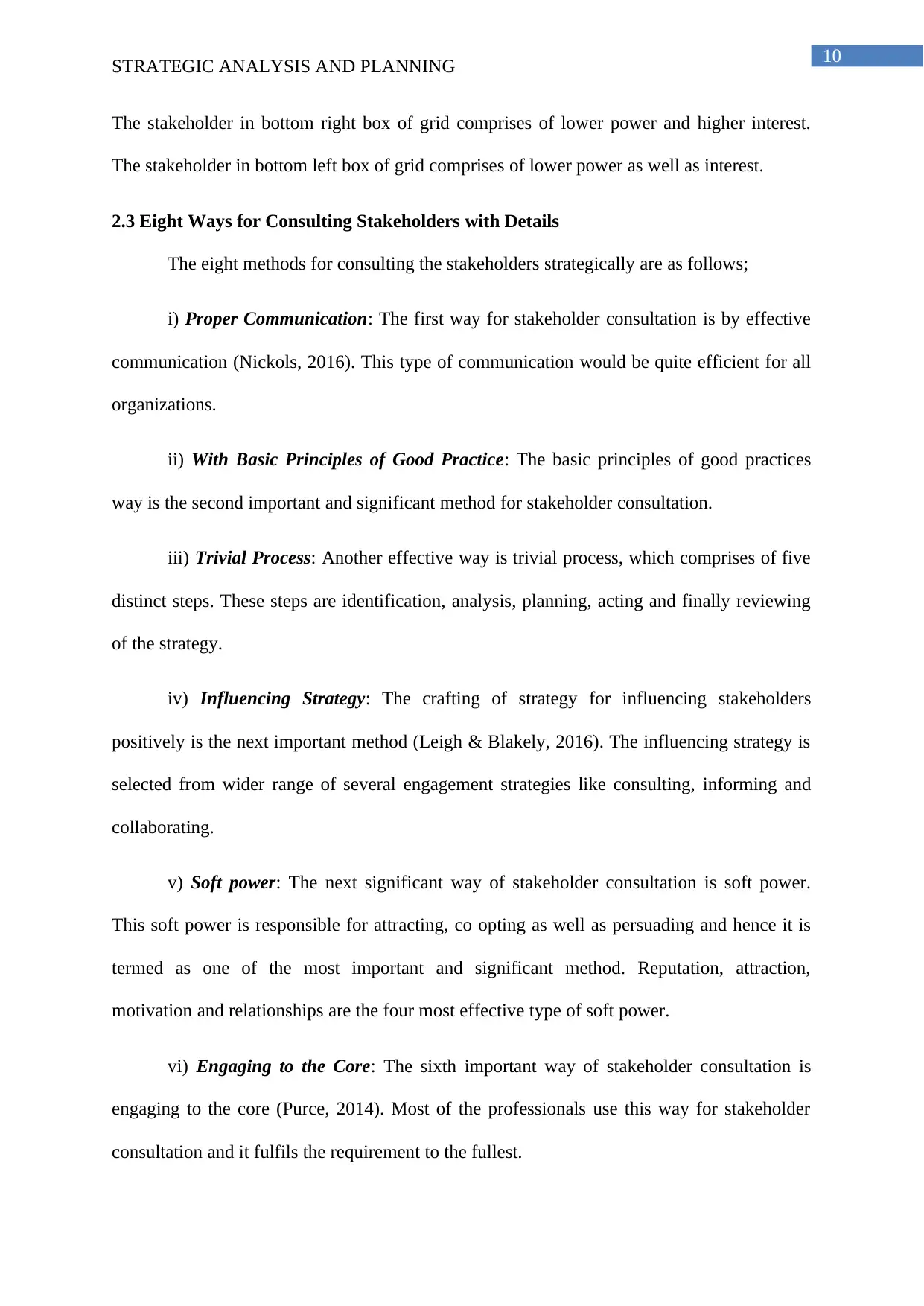
10
STRATEGIC ANALYSIS AND PLANNING
The stakeholder in bottom right box of grid comprises of lower power and higher interest.
The stakeholder in bottom left box of grid comprises of lower power as well as interest.
2.3 Eight Ways for Consulting Stakeholders with Details
The eight methods for consulting the stakeholders strategically are as follows;
i) Proper Communication: The first way for stakeholder consultation is by effective
communication (Nickols, 2016). This type of communication would be quite efficient for all
organizations.
ii) With Basic Principles of Good Practice: The basic principles of good practices
way is the second important and significant method for stakeholder consultation.
iii) Trivial Process: Another effective way is trivial process, which comprises of five
distinct steps. These steps are identification, analysis, planning, acting and finally reviewing
of the strategy.
iv) Influencing Strategy: The crafting of strategy for influencing stakeholders
positively is the next important method (Leigh & Blakely, 2016). The influencing strategy is
selected from wider range of several engagement strategies like consulting, informing and
collaborating.
v) Soft power: The next significant way of stakeholder consultation is soft power.
This soft power is responsible for attracting, co opting as well as persuading and hence it is
termed as one of the most important and significant method. Reputation, attraction,
motivation and relationships are the four most effective type of soft power.
vi) Engaging to the Core: The sixth important way of stakeholder consultation is
engaging to the core (Purce, 2014). Most of the professionals use this way for stakeholder
consultation and it fulfils the requirement to the fullest.
STRATEGIC ANALYSIS AND PLANNING
The stakeholder in bottom right box of grid comprises of lower power and higher interest.
The stakeholder in bottom left box of grid comprises of lower power as well as interest.
2.3 Eight Ways for Consulting Stakeholders with Details
The eight methods for consulting the stakeholders strategically are as follows;
i) Proper Communication: The first way for stakeholder consultation is by effective
communication (Nickols, 2016). This type of communication would be quite efficient for all
organizations.
ii) With Basic Principles of Good Practice: The basic principles of good practices
way is the second important and significant method for stakeholder consultation.
iii) Trivial Process: Another effective way is trivial process, which comprises of five
distinct steps. These steps are identification, analysis, planning, acting and finally reviewing
of the strategy.
iv) Influencing Strategy: The crafting of strategy for influencing stakeholders
positively is the next important method (Leigh & Blakely, 2016). The influencing strategy is
selected from wider range of several engagement strategies like consulting, informing and
collaborating.
v) Soft power: The next significant way of stakeholder consultation is soft power.
This soft power is responsible for attracting, co opting as well as persuading and hence it is
termed as one of the most important and significant method. Reputation, attraction,
motivation and relationships are the four most effective type of soft power.
vi) Engaging to the Core: The sixth important way of stakeholder consultation is
engaging to the core (Purce, 2014). Most of the professionals use this way for stakeholder
consultation and it fulfils the requirement to the fullest.
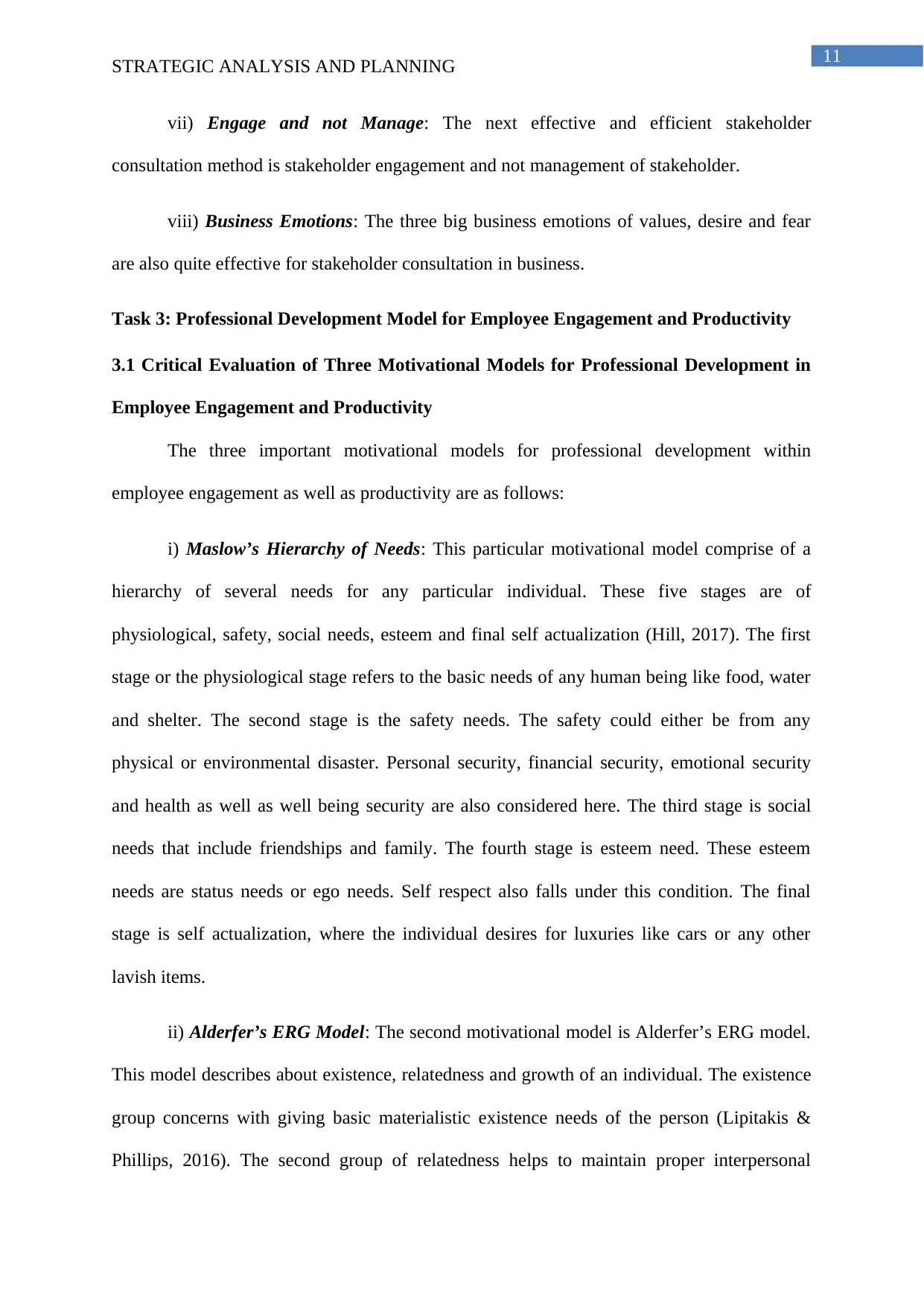
11
STRATEGIC ANALYSIS AND PLANNING
vii) Engage and not Manage: The next effective and efficient stakeholder
consultation method is stakeholder engagement and not management of stakeholder.
viii) Business Emotions: The three big business emotions of values, desire and fear
are also quite effective for stakeholder consultation in business.
Task 3: Professional Development Model for Employee Engagement and Productivity
3.1 Critical Evaluation of Three Motivational Models for Professional Development in
Employee Engagement and Productivity
The three important motivational models for professional development within
employee engagement as well as productivity are as follows:
i) Maslow’s Hierarchy of Needs: This particular motivational model comprise of a
hierarchy of several needs for any particular individual. These five stages are of
physiological, safety, social needs, esteem and final self actualization (Hill, 2017). The first
stage or the physiological stage refers to the basic needs of any human being like food, water
and shelter. The second stage is the safety needs. The safety could either be from any
physical or environmental disaster. Personal security, financial security, emotional security
and health as well as well being security are also considered here. The third stage is social
needs that include friendships and family. The fourth stage is esteem need. These esteem
needs are status needs or ego needs. Self respect also falls under this condition. The final
stage is self actualization, where the individual desires for luxuries like cars or any other
lavish items.
ii) Alderfer’s ERG Model: The second motivational model is Alderfer’s ERG model.
This model describes about existence, relatedness and growth of an individual. The existence
group concerns with giving basic materialistic existence needs of the person (Lipitakis &
Phillips, 2016). The second group of relatedness helps to maintain proper interpersonal
STRATEGIC ANALYSIS AND PLANNING
vii) Engage and not Manage: The next effective and efficient stakeholder
consultation method is stakeholder engagement and not management of stakeholder.
viii) Business Emotions: The three big business emotions of values, desire and fear
are also quite effective for stakeholder consultation in business.
Task 3: Professional Development Model for Employee Engagement and Productivity
3.1 Critical Evaluation of Three Motivational Models for Professional Development in
Employee Engagement and Productivity
The three important motivational models for professional development within
employee engagement as well as productivity are as follows:
i) Maslow’s Hierarchy of Needs: This particular motivational model comprise of a
hierarchy of several needs for any particular individual. These five stages are of
physiological, safety, social needs, esteem and final self actualization (Hill, 2017). The first
stage or the physiological stage refers to the basic needs of any human being like food, water
and shelter. The second stage is the safety needs. The safety could either be from any
physical or environmental disaster. Personal security, financial security, emotional security
and health as well as well being security are also considered here. The third stage is social
needs that include friendships and family. The fourth stage is esteem need. These esteem
needs are status needs or ego needs. Self respect also falls under this condition. The final
stage is self actualization, where the individual desires for luxuries like cars or any other
lavish items.
ii) Alderfer’s ERG Model: The second motivational model is Alderfer’s ERG model.
This model describes about existence, relatedness and growth of an individual. The existence
group concerns with giving basic materialistic existence needs of the person (Lipitakis &
Phillips, 2016). The second group of relatedness helps to maintain proper interpersonal
⊘ This is a preview!⊘
Do you want full access?
Subscribe today to unlock all pages.

Trusted by 1+ million students worldwide
1 out of 17
Related Documents
Your All-in-One AI-Powered Toolkit for Academic Success.
+13062052269
info@desklib.com
Available 24*7 on WhatsApp / Email
![[object Object]](/_next/static/media/star-bottom.7253800d.svg)
Unlock your academic potential
Copyright © 2020–2025 A2Z Services. All Rights Reserved. Developed and managed by ZUCOL.




